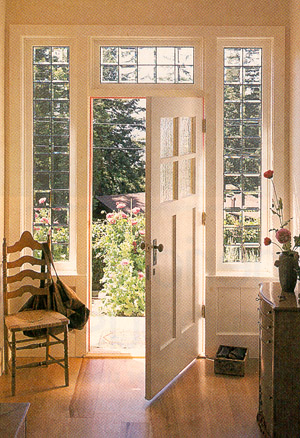We believe that people need and have a right to determine and shape their own environment.
We also believe that they are the only ones who know in a profound way what they need and know more details, necessary to the creation of a good environment, and that good architecture can only come from wholehearted involvement of the users in the shaping of their buildings and streets.

We need to respect and cherish the particular human qualities that make each country, each people, each region unique, and must pay attention to the subtlety of human value as it arises in different contexts.
We not only provide you with the methods by which you can design something for yourself so that it truly meets your needs.
We also provide you with a practical context that gives you the means to realize the project, and get it built cheaply, and well, and to your liking.

This practical umbrella that we provide you with includes ways of estimating the cost of what you want to do, checking cost, and doing it within budget, and can also provide you with a variety of ways of managing the project, large or small, so that the dream you have, and express first by means of simple sketches, can then be realized in practice. Although the work on this web site can be playful, and can realize dreams: it is always taking place within a framework of experience and practice that gives you the potential to make your dream come true, at reasonable cost, and in ways which leave control in your hands.
What we mean by a good building is one that has a certain quality, what we normally call "life."
In a living environment, as we define it, the people who live and work there are relaxed, know that they belong there and enjoy a kind of freedom in relation to the buildings and space around them. They feel and are "at home" in their world.

In looking around us we can most frequently see this quality in traditional buildings and towns, where, over the years, people have constructed an orderly but loose configuration of space, rooms, gardens, houses, and larger buildings. The later 20th century, for varied and complex reasons, has not seen much in the way of living buildings and neighborhoods.

We do not wish to engage in a nostalgia for past centuries, but to develop a modern interpretation of living structures that can speak to us, our cultural specificity, and to our times, and yet reach this deep understanding of spatial arrangements that support rather than deny humanity and ordinary daily events.

Many ingredients are required to make a living structure: an understanding of space and human response to it, appropriate technology and materials., constructing, from the outset, with and for the people who will adopt that space as their own, and even arranging for the way that money flows for initial construction, later repairs, adaptation, and growth. The key is in understanding and developing the processes by which living environments can come into existence and prosper.
Sometimes a picture is worth a thousand words. The Picture Gallery shows you some of the buildings we have made in this spirit.
The team of people creating PatternLanguage.com have spent decades of work directed at understanding what makes for good and bad buildings, buildings that have life in them and provide the supportive surroundings we need. We have spent decades developing building processes appropriate to our times that will lead to good buildings with strong user participation and sensible spending. We know that there are viable alternatives to strip malls, tract housing and absurdly inappropriate and alienating buildings and we know how to build them.

Now web technology, like Guttenberg's printing press, radically changes the availability of these alternate ways of building. We have formed PatternLanguage.com as an internet corporation, and as an outgrowth of thirty years of work at done at THE CENTER FOR ENVIRONMENTAL STRUCTURE.
The web site is dedicated to reaching people of all walks of life who share our concern. In small ways (the design of a garden, the refurbishing of an attic into an extra room), or in larger ways (the revamping of a neighborhood, planning for a new office building), we all play our part in shaping our environment, which in turn shapes us.

On the pages of this web site you will find the tools: patterns, sequences, building processes, project management information, to do these things. We address both the lay person and the professional architect and builder who have different but largely overlapping needs and who must work together.

Please explore the web site and visit us often. The website can:
You in turn can join and help us build a community of people around the world devoted to reshaping the earth. Many of the pages on this web site are accessible free, to any user who logs on. Some require a modest fee. Please explore and enjoy the site.

A pattern is a careful description of a perennial solution to a recurring problem within a building context, describing one of the configurations which brings life to a building.
A pattern language is a network of patterns that call upon one another. An individual house might, for example, call upon the patterns described under the names of half-hidden garden, light from two sides in every room, variation of ceiling height, bed alcove, etc. Patterns help us remember insights and knowledge about design and can be used in combination to create designs.

The use of patterns can be and is widespread and not limited to professionals.
The 253 patterns are available on the site, in hypertext, to members only, here.
A sequence is an algorithm or recipe for describing which steps and decisions need to be taken and in what order for successful building. A sequence can be developed for anything, how to lay out an office, how to build a cottage, a parking lot, a campus, a neighborhood.
The demo shows a sequence for entrance transition, and how to use the sequence.

Designing and building with sequences is very different from mainstream practice of architecture and of CAD-based design and management tools. Standard design and CAD methods force decisions at the wrong stage; a standard blueprint is a multitude of guesses about what might be right; a stand contract makes the guesses binding or, at least, costly to unbind. Feedback and step by step adaptation are precluded. To use a simple metaphor, a standard plan is like putting down 50 pennies and trying to flip them on to "heads" at the same time (slim odds). Sequences are about flipping one penny at a time, getting it right, and then flipping the second one. The chances for success are much higher, it doesn't take more time or cost more money, but it does require working differently. It also means paying attention to subtle and critical aspects of space, light, volume in ways that are different and make all the difference.

Sequences are about unfolding. To take a biological example, a human embryo will develop through the repetition of simple steps, but a mishap in the sequence will mean malformation. During normal growth what happens at any given stage is a preserving and enhancement of the previous stage. Although all embryos unfold in a similar way, they all come out slightly different: we all have our own special faces and fingerprints. Sequences, with appropriate support from computers, and building processes can allow for each building to exactly fit needs and do so at a very good cost. They allow a layperson and a builder to understand each other about what is exactly wanted and needed. More profoundly, they allow for better buildings.
Please do try our demo sequence for entrance transitions and experience it for yourself.
In the practices we have used for thirty years of design and construction, a special approach to cost has always played an essential role. You will often hear that good things cannot be made without spending more money. That simply is not true.
The essence of good design, and good building, is to work, from the beginning to the end of a project, with a tight and careful attitude toward cost control, always thinking about money, and the best use of the available budget, as a major feature of what is done. This must occupy us from the first day to the last.

To create a living architecture does not require the use of more money than usual. It requires that the use of money is different, and that thought is given, from the first day, as to where to put the available money, and how to divide up the budget that you have, and how to keep the actual construction work so that it sticks to that budget.
Although it is not easy to introduce these methods via a web site, we shall do our best to pass on to you the techniques we have developed, so that you and the people who work for you, can apply these methods to the projects which are done by you, and for you, using the techniques available on this site.

The emphasis of this web site—and the source of its power as a tool which can help you design things for yourself—is on sequences: sequences of patterns which allow a person to design a coherent building and which help to make it more probable that the building, as designed, has life and living structure. These generative sequences are sophisticated and powerful, and flexible.

